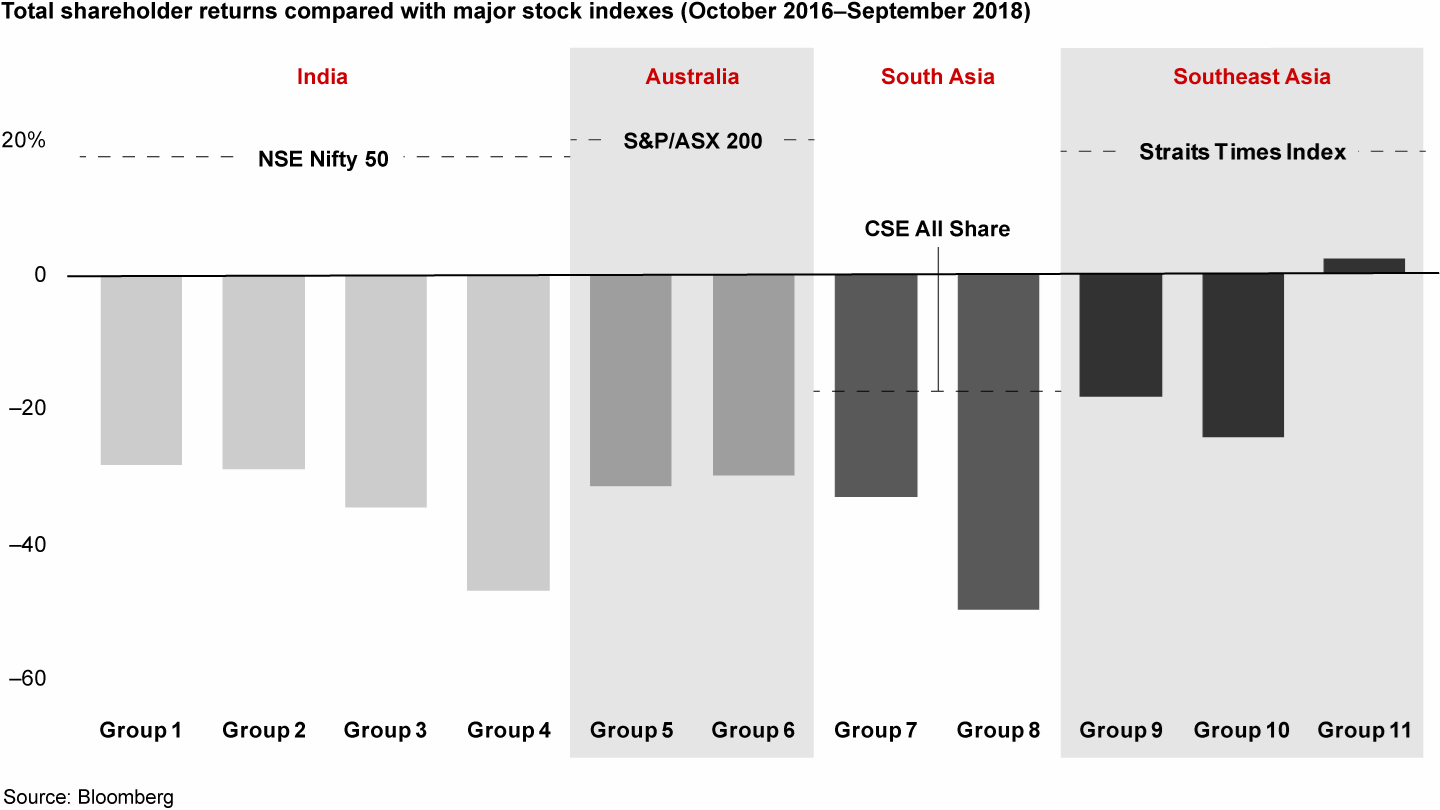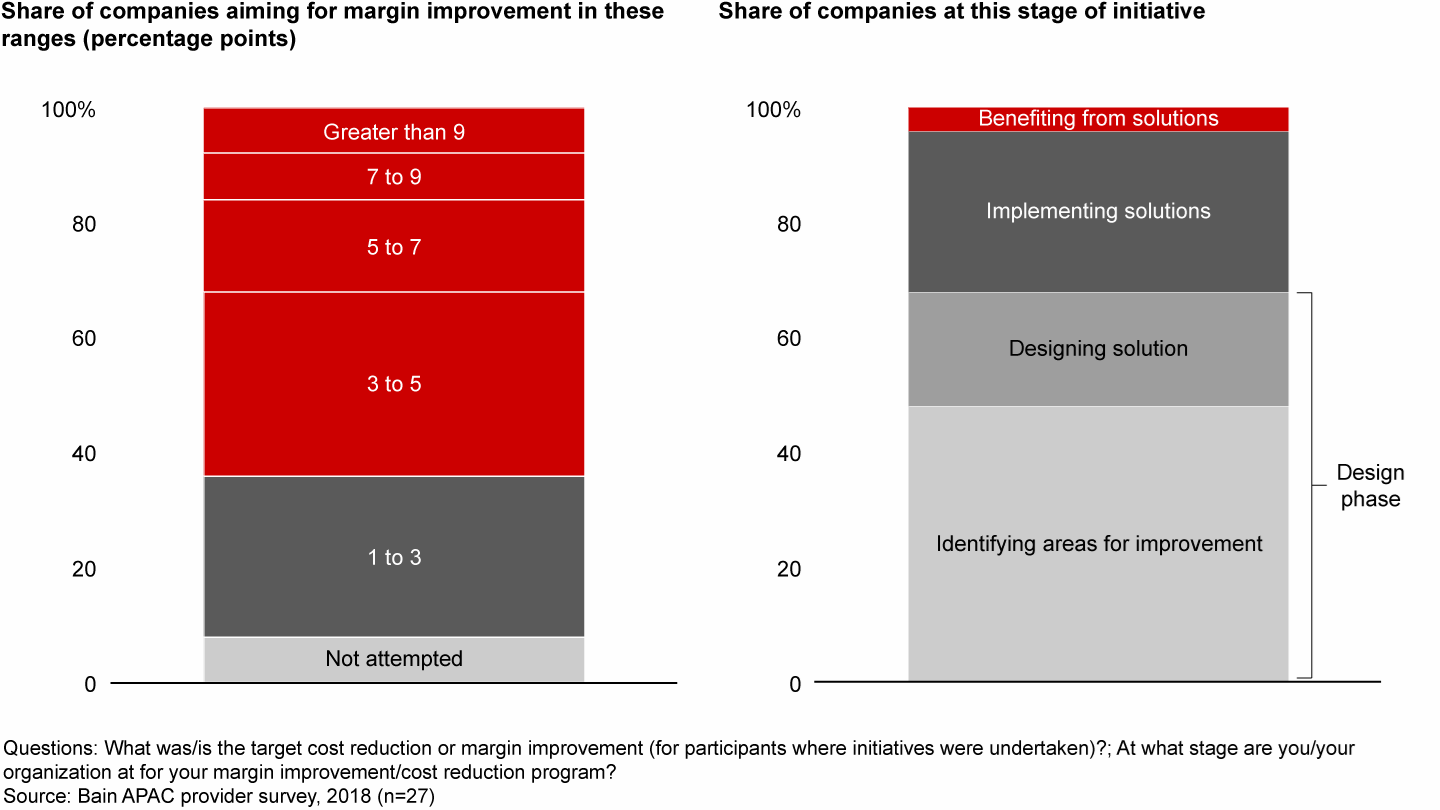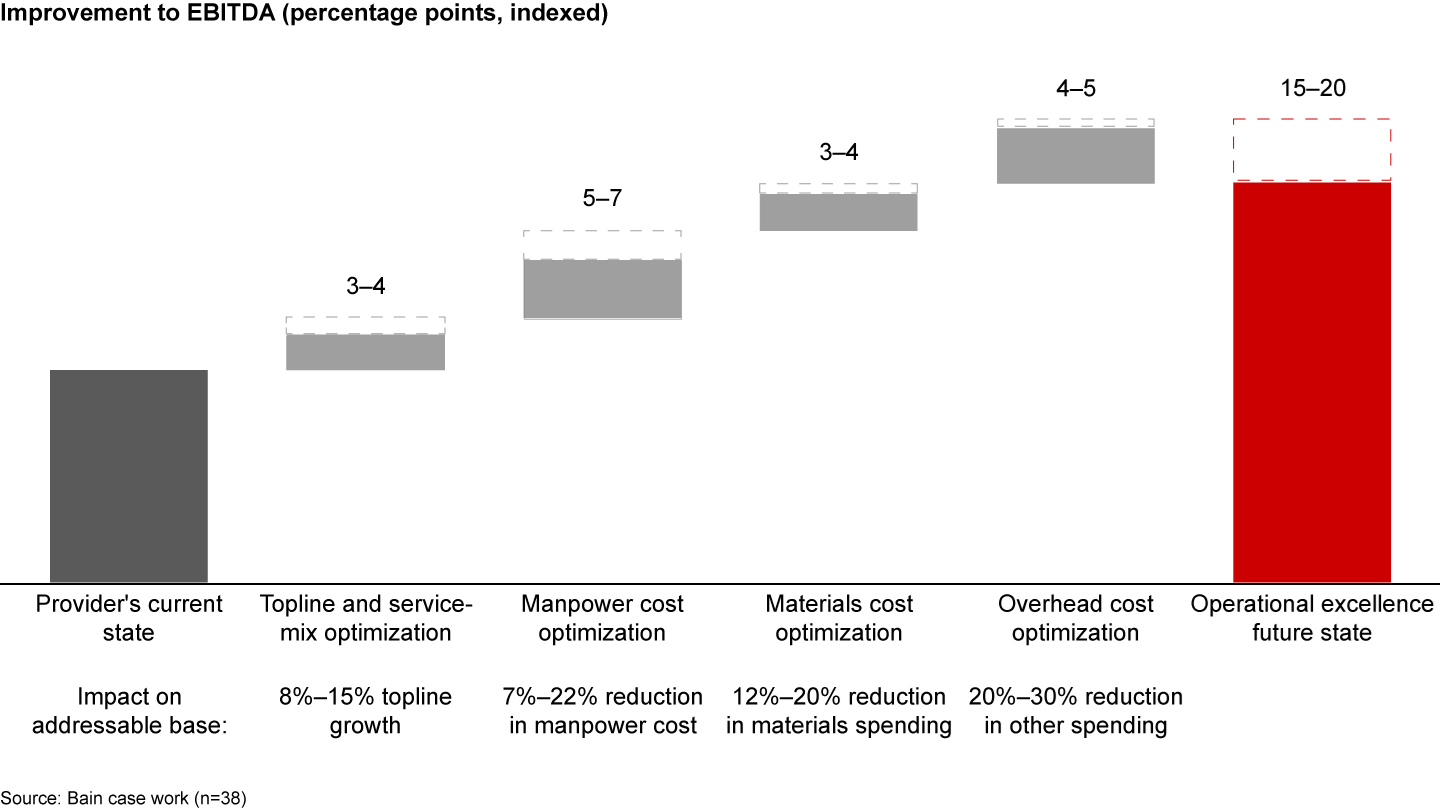Brief

한눈에 보기
- Many hospital groups and healthcare providers in the Asia-Pacific region delivered negative total shareholder returns from 2016 to 2018.
- Sixty percent of providers have launched ambitious performance improvement efforts, but fewer than 5% say they are producing benefits.
- Zero-based redesign programs can increase provider profitability by as much as 15 to 20 percentage points.
Healthcare systems in the Asia-Pacific region vary widely from country to country, but face a common challenge: lackluster financial performance in an environment of unprecedented healthcare demand. Rising costs, evolving regulations and reimbursement pressure have eroded profits. From 2016 to 2018, major hospital groups in Australia, India, South Asia and Southeast Asia significantly underperformed their respective markets, and many leading providers delivered negative total shareholder returns (see Figure 1).
Asia-Pacific hospital groups performed poorly from 2016–18


For leadership teams, it’s a frustrating dilemma. Ninety percent of providers in the region pursued performance improvement initiatives over the past two years, according to a recent Bain survey, and 60% of respondents targeted ambitious margin improvement of three percentage points or more. But fewer than 5% say they are getting benefits from their efforts (see Figure 2). Seventy percent say they expect to fall short of achieving their target.
About 60% of Asia-Pacific providers want to improve margins 3 percentage points or more, but fewer that 5% are seeing benefits


A few providers, however, are outperforming by taking a more radical approach to operational excellence through zero-based redesign (ZBR). Companies using ZBR start with a blank sheet to completely rethink processes and workflows and realign their operating model. They use digital technologies to either eliminate or streamline activities and data analytics to unearth additional gains. Bain research shows ZBR can increase providers’ EBITDA growth by as much as 15 to 20 percentage points (see Figure 3).
Zero-based redesign programs can improve provider earnings growth by 15 to 20 percentage points


A new approach to cost savings
Many Asia-Pacific providers have realized that short-term cost cutting is ineffective. In most cases, the costs creep back in a couple of years. Worse, such moves often jeopardize vital services, undermining clinical quality and patient experience, while weakening processes and accountability. Providers in our survey identified four risks to significantly improving performance: Failure to engage the entire organization, adverse effects from cutting costs, inability to sustain change, and an incremental approach.
ZBR’s blank-sheet approach helps companies overcome those risks and achieve operational excellence. Leadership teams that deliver the biggest gains through ZBR understand it isn’t a cost-cutting tool, but a major shift in cost-management philosophy. ZBR aligns processes and resources with the organization’s mission. It starts with setting a clear vision that includes aspirational cost and revenue targets. Next comes a bottom-up redesign of all processes, disregarding how the company did things in the past.
To do that, the leadership team answers two key questions. First, what activities should the company perform? That includes identifying wasteful activities to eliminate and assessing risk. Second, how should we perform those activities? Could reengineering and digitalization improve performance? In many cases, simple, inexpensive digital solutions that were unavailable a few years ago can turbocharge ZBR results. Automating tasks and processes in specific functions, for example, typically reduces costs by 25% to 50%, and in some cases as much as 65%.
Companies that focus on these two questions uncover new sources of savings that traditional approaches miss. By probing which activities should be performed, a leading provider in India discovered nonessential and duplicative documents were creating a lot of unnecessary work for nurses. The leadership team eliminated excess documentation and redesigned forms for simplicity and digitization. Those actions reduced the time nurses spent on documentation by 65%.
Digitalization also makes it easier to reduce errors and speed customer-response time. It enables companies to gather and organize data quickly, helping them optimize processes. A leading hospital chain reduced discharge time by 40% by enabling multiple departments to see pending workflow items and implementing early notifications. Another major hospital chain cut costs 20% for specific surgical items by studying the variations in costs across its network and standardizing usage.
A few leaders are discovering how quickly digital technologies can deliver results. Take the case of an Australian provider that rapidly expanded from its strong, local base, but found its new clinics were missing revenue and profit targets. The leadership team used digitally enabled process redesign to reduce high fixed costs. It then introduced micromarket and customer-based pricing, and profits quickly rose by 35%. An Agile approach to new business development at all sites allowed the leadership team to benchmark and improve performance throughout the network. A year later, the provider’s profit had tripled.
Providers are also using a blank-sheet approach to achieve breakthrough results. A hospital chain in Asia struggling with margin pressure used zero-based redesign to rethink its pricing strategy and improve profitability. The leadership team scrapped the hospital’s cost-plus-margin pricing approach and developed a more holistic system based on the medical team’s experience and the complexity of the procedure. The new pricing system, rolled out across major hospitals in the chain, increased revenue growth by roughly 8 percentage points.
In another case, a standalone secondary hospital in the region launched a wide-ranging ZBR program to stem rising costs and reverse growing losses. Key changes at the hospital, which serves company employees and the surrounding region, included a shift to value-based pricing; reduced admission, diagnostic and discharge turnaround times; and lower staff costs through improved use of physicians and outsourced nursing staff. The program improved earnings before interest and taxes by 6% in 2017, and the hospital expects to reduce its losses 30% to 40% by 2022.
Getting ZBR right
Despite the potential gains, many healthcare providers have been slow to adopt ZBR. One reason is that leadership teams often misunderstand it. The companies that succeed with zero-based redesign follow four guidelines:
Make it a top management priority. Leadership teams align on the bold mission first and make the case for change. They build deep commitment at all levels of the organization before launching a ZBR program. The CEO, CFO and senior executives make it clear to all that ZBR isn’t a mechanical cost-cutting tool. It’s a new approach that changes the way the organization views spending and creates a high-performance culture.
Focus on strategic costs vs. nonstrategic costs. Many associate ZBR with across-the-board cutting. That’s a misconception and the wrong starting point. Zero-based redesign helps a company distinguish between strategic and nonstrategic costs. The goal isn’t to slash spending, but to rethink and rebalance how the company spends every dollar so it supports investment priorities.
Link savings to growth. Too often, companies overlook the most strategic aspect of zero-based redesign—rechanneling savings to fuel growth. That kindles employee engagement and an ownership mindset, which both help ensure a ZBR program’s success. Ultimately, a well-designed zero-based redesign program simplifies the organization and eliminates the clutter that makes it hard for employees to do their jobs, liberating high performers.
Pave the way for behavior change. Even when companies strive to craft an effective ZBR program, they may stumble in executing it. One common pitfall is focusing on the tools, benchmarking and pace of the rollout, instead of training people in a new set of behaviors. Tools improve financial performance only if managers and the front line use them to change the way they manage costs.
Over the next decade, with its rapidly aging population and increasing prevalence of chronic disease, the Asia-Pacific region will account for half of the growth in global healthcare spending. That will put pressure on hospital groups and other providers to make healthcare services more efficient and affordable. What separates the winners from the losers will be management teams that put operational excellence on the top of their strategic agenda. Harnessing a ZBR approach to managing hospital systems will over time become a source of distinct competitive advantage for these winning leadership teams.
Vikram Kapur is a partner with Bain & Company and leads the firm’s Healthcare practice in Asia-Pacific. He is based in Singapore. Satyam Mehra and James Viles are partners in Bain & Company’s Healthcare practice. Satyam is located in the New Delhi office, and James is based in Sydney. Arunava Dalal is a principal in Bain’s Healthcare practice and is based in Bain’s New Delhi office.